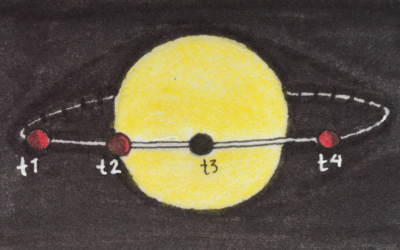BloG
Welcome to the EOS/Alien Earths team's Blog where we share the research results we are most excited about.Methods for Hunting Exoplanets
“Usually the first thing you find in astronomy are the freaks,” said Dr. Travis Barman, Project EOS co-investigator and associate professor at the University of Arizona. “And the freaks tell you about the exceptions not the rule.” Exoplanets are illusive objects. They...
New Directions in Planet Formation – Gijs Mulders
How do planets form? This is a question that scientists have asked themselves for centuries. Kant (in 1755) and Laplace (in 1796) postulated the nebular hypothesis, which states that the solar system planets formed from a rotating disk of material. Over the years...
Hunting for Exoplanets: Direct Imaging
A strange and new extrasolar system was discovered by graduate research fellow and Project EOS collaborator Kevin Wagner, principal investigator for Project EOS Daniel Apai, and assistant professor of astronomy at the University of Arizona Kaitlin Kratter, announced...
Mapping the atmospheres of exotic worlds: from brown dwarfs to Earth 2.0
Discovering Earth 2.0, another planet like our Earth that could host life on its surface, requires us to characterize the atmosphere of the planet. An important feature we need to study is the clouds in that atmosphere. What are they made of? How are they...
Planet-Forming Disks
The solar system formed when an enormous cloud of gas and dust began to collapse and rotate. As it spun faster and faster, it formed a disk which helped feed into forming the young sun in the center of it all. From this disk, small particles of dust started sticking...
Climate Stability and a Hike along a Triassic Coral Reef
From the DistantEarths blog of Daniel Apai After two hours of hike up on a rocky trail in the Italian Alps, finally I stand at an elevation just above 2,500 meters, staring at a breathtaking and unique mountain range, the Dolomites, that holds an exciting clue to the...
Taking Pictures of Alien Worlds
We know of a lot of exoplanets. Most, though, we know of only by indirect means – typically via the planet occulting some of the starlight during an eclipse or changing the star’s velocity due to the planet’s own gravity. As of today (June 29, 2016) the exoplanet...
Building Planetary Systems: The Genesis Database
The planets of our solar system formed out of a swirling disk of gas and dust billions of years ago. The material that accreted to become the Earth lacked water and organic material because it formed at a distance that was too close to the sun for such...
The Future of Exoplanet Research
By Daniel Apai Includes interview with Nick Siegler and Shawn Domagal-Goldman Over the weekend, at the Hilton on the San Diego Bay, a small group met to speak about the present and future of NASA's Exoplanet Exploration program. To someone not in the field of...
Meteorites: Time Capsules of the Solar System
Just before 4 a.m. on June 2, Arizona’s night sky seemed to momentarily catch fire. A meteor, about 5-feet across, burned through the atmosphere at 40,200 mph, according to NASA estimates. The small debris that reached the Earth’s surface are called meteorites, and...
Dust grains, frogs, and the formation of habitable planets
The Sun’s planetary system, like the many other systems discovered in the last 2 decades, formed out of a protoplanetary disk. These disks are a natural by-product of star formation (almost every young star has one) and consist of a lot of gas (mostly hydrogen) and a...
Hubble Directly Measures Rotation of Cloudy ‘Super-Jupiter’
Astronomers using NASA's Hubble Space Telescope have measured the rotation rate of an extreme exoplanet by observing the varied brightness in its atmosphere. This is the first measurement of the rotation of a massive exoplanet using direct imaging. "The result is very...

